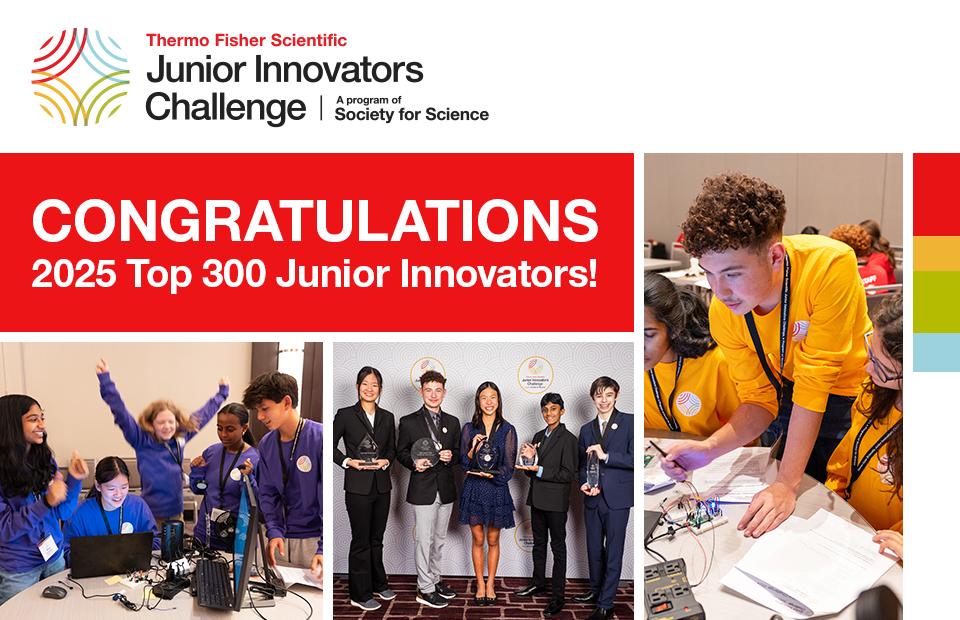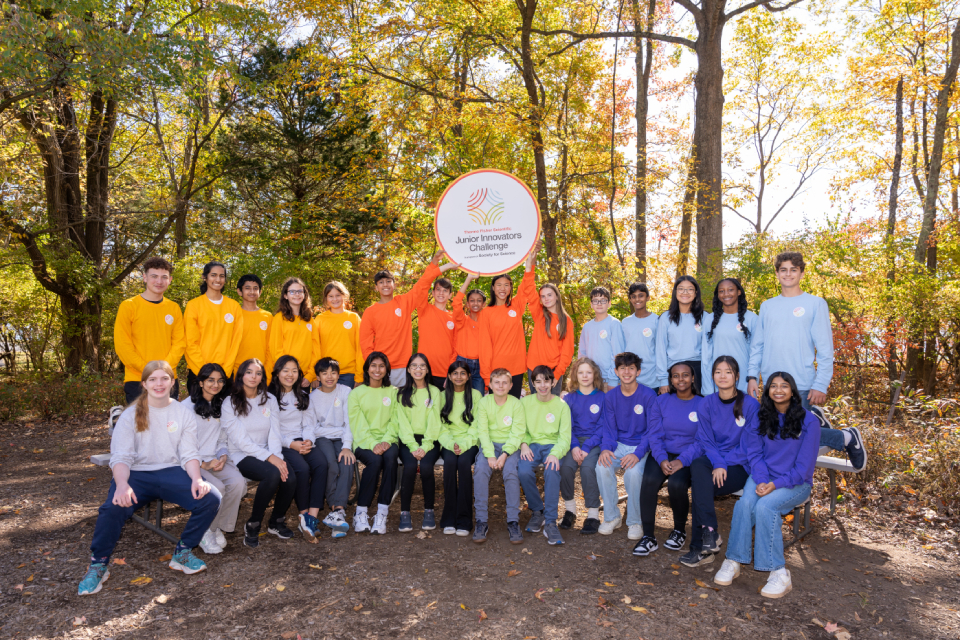2025 Thermo Fisher Scientific Junior Innovators Challenge Finalists
Society for Science and Thermo Fisher Scientific are proud to announce the 30 finalists in the 2025 Thermo Fisher Scientific Junior Innovators Challenge — the nation’s premier STEM research competition for middle school students. The finalists will travel to Washington, DC from October 24 – 29 to participate in the Finals Week of the competition. Each student will be judged on both their science research projects as well as their demonstration of collaboration and critical thinking skills during team challenges, emphasizing the importance and value of teamwork in STEM fields.
All finalists receive a $500 cash award and will compete for over $100,000 in prizes.
View the Press ReleaseMeet the 2025 Finalists!
Rajsi Choudhary
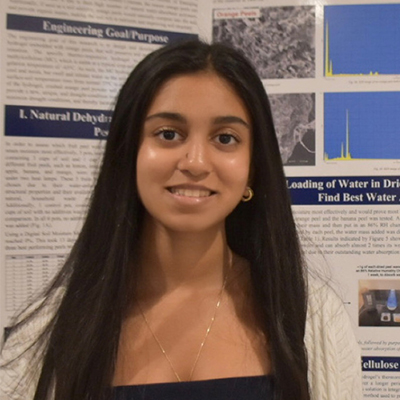
8th Grade, Eastern Middle School
Riverside, CT
Fabrication of a Biodegradable, Nutrient-Rich, Orange Peel-Loaded Hydrogel for Thermally-Programmed Release of Water To Maintain Soil Moisture
Project Background: Summers in Ahmedabad, India, Rajsi’s hometown, reach scorching temperatures of 104°F. When she retreated to air conditioning, Rajsi found herself looking at a mango tree out the window and wondering how the fruit stayed hydrated as the heat baked everything else. Nearly 70% of fresh water on Earth is used in agriculture, and climate change means many crops will need more. Rajsi began to study how fruit peels retain moisture and decided to see if fruit peels could help the soil stay moist.
Tactics and Results: Rajsi found that of orange, banana, apple, lemon and mango, orange peels had the highest moisture, with 88 percent water content. Rehydrating orange peels showed that they could absorb twice their weight in water. Rajsi then created an orange peel hydrogel and mixed it into soil, comparing it against a soil with a normal hydrogel, and one with no gel at all. She gave them 15.5% moisture and exposed them to natural sunlight for 80 hours. In the first 24 hours, normal soil lost 22.6 percent of its moisture, while her gel lost only 10 percent. After 80 hours, normal soil lost 53.3 percent of its water, and with a normal hydrogel lost 41.1 percent of its water, but the orange peel hydrogel soil lost only 28.4 percent. Crops like corn require 9,000 gallons of water per acre per day, and she estimates her orange peel gel could save 1,134 gallons per day.
Other Interests: Rajsi likes to play squash as a break from her time in the lab. “In the lab, I often find myself spending countless hours in a state of deep focus, where my mind is very active but my body is rather still. In contrast, while rallying on the squash court, I get the opportunity to exercise and give my brain a different kind of focus,” she says. Rajsi would like to be an environmental engineer, to help address problems like climate change and water scarcity.
Seungah Chung
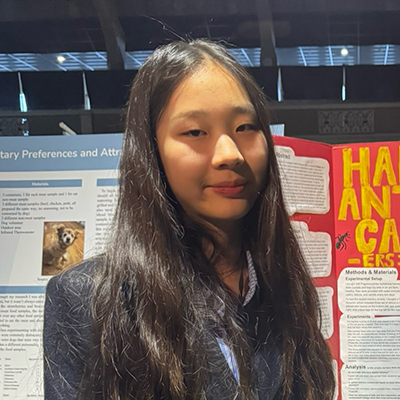
8th Grade, Beverly Vista Middle School
Beverly Hills, CA
Investigating Spatial Memory Formation in Harvester Ants Through Operant Conditioning
Project Background: For something so tiny, ants have incredible memories. They explore new environments and bring back food, laying chemical trails to lead others in their nest to a feast. “What fascinates me is how they manage to do this with such small brains, while mammals rely on much larger, more complex systems,” Seungah says. Her previous project had explored whether ants could build maps of their environments when they hunted for food, and this time, she wanted to find out what kind of cues the insects use to give them directions.
Tactics and Results: Seungah used 200 red harvester ants (Pogonomyrmex barbatus) in an ant farm. She tested 15 ants at a time in a small maze. The maze was shaped like a T and offered a delicious tangerine reward at the end of the left arm. When the ants started at the bottom of the T, they navigated around fake leaves, sea rocks and building blocks to eventually find their tasty treat. Seungah gave them time to learn the maze and then tested them one at a time 30 minutes later. The ants did not remember where the reward was very well. But when Seungah reversed the placement of the leaves, rocks and building blocks, the ants got more confused, turning right when they should turn left. She concluded that the ants were navigating based on landmarks rather than general direction.
Other Interests: Seungah is an artist, and joined a group called Ariari21, which uses art in community service. She helps to paint murals in homeless shelters and senior living centers to create welcoming and warm spaces. Seungah would like to become a microbiologist, and her role model is Katalin Karikó, who won the 2023 Nobel Prize in Physiology or Medicine for her work on mRNA. “I constantly imagine new infections in my head, looking for new ways to fight bacteria once antibiotics resistance takes over,” Seungah says.
Zeynep Demirbas
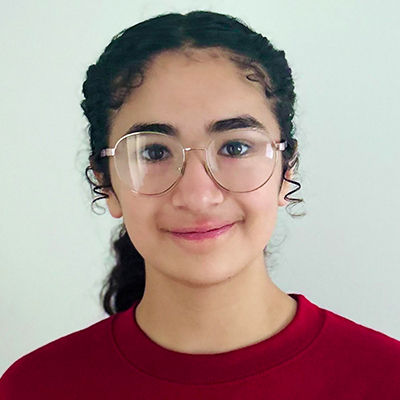
8th Grade, Transit Middle School
East Amherst, NY
Evaluating the Reliability of Large Language Models for Stress Detection
Project Background: Zeynep has been fascinated by ChatGPT since it was released in 2022. She was especially interested in how some users and businesses felt it could be trusted—even with mental health. One of Zeynep’s family friends is a psychologist. “She mentioned how health insurance companies were exploring large language models (LLMs) as cheaper 24/7 alternatives to human therapists,” Zeynep says. “She was concerned about her job safety.” Zeynep wondered if today’s LLMs like ChatGPT could replace therapists and decided to start by asking if the programs could detect stress.
Tactics and Results: Zeynep wanted to compare several LLMs to see if they could detect stress in human text. She used a Dreaddit dataset, which is a group of 3,553 Reddit posts that humans have labeled with stress or no-stress, and gave the data to four different LLMs: Bidirectional encoder representations from transformers (BERT), a version of BERT called MentalBERT for mental health, Random-Forest (a basic machine learning technique), and Chat-GPT4o. She asked the models to identify stress and score their confidence. Zeynep found that MentalBERT performed best, identifying stress precisely 82.4 percent of the time. BERT performed at 79.4 percent. ChatpGPT-4o identified stress precisely only 73.7 percent of the time, worse than the basic machine learning Random-Forest, which doesn’t understand language or context at all. “My project shows that LLMs are currently unreliable and unsafe to deploy as diagnostic tools,” Zeynep says.
Other Interests: Zeynep is on the track team and holds school records in shot put. She plays the viola in a chamber group and likes to play chess online, playing with people around the world. She also helps her mom make traditional Turkish meals. “One of my favorite memories is back when I was learning to make ‘sarma,’” she says. “We laughed as I struggled to roll grape leaves.” Zeynep would like to be a computer scientist. “I enjoy writing programs, but I’m even more excited by what they mean in the real world.”
Archishman Dey

8th Grade, Solon Middle School
Solon, OH
How Do Various PM₂̣ ₅ Pollutants Affect Indoor Air Pollution?
Project Background: People might assume that the air inside their houses is clean, but tiny particles 2.5 microns or less across (called PM₂̣ ₅), are often still present. Archishman was concerned to learn that PM₂̣ ₅ can decrease productivity and accounted for 3.2 million deaths in 2021. “I was most curious about the daily burning of incense sticks at my grandparents’ home, where you could visibly see smog in the air,” Archishman says. His grandparents have asthma, and he was concerned for their health. Archishman decided to quantify the PM₂̣ ₅ levels of different pollutants in indoor air.
Tactics and Results: Archishman got a monitor for PM₂̣ ₅, and designated one room as a control area. He measured the PM₂̣ ₅ levels at baseline, between 1.52 and 2.06 micrograms per square meter. Then Archishman lit up or turned on different pollutants, keeping each about two feet away from the monitor. He tested an air fryer, a candle, a humidifier, an incense stick and the natural gas used in things like gas stoves. Archishman found that the incense stick was the highest level, emitting an average of 76.27 micrograms per square meter. The air fryer came in second with 14.29 micrograms of PM₂̣ ₅ per square meter. Even a humidifier produces about 5.5 micrograms per square meter. “I aimed to provide simple data that could enable families to recognize invisible air quality dangers and adopt healthier practices with the aim of improving their indoor environment,” he says.
Other Interests: Archishman likes competitions like the Science Olympiad and MathCounts, where he represented Ohio at the national competition. “Cracking the code to a problem after tireless thought is what I find most enjoyable,” he says. He would like to be an environmental engineer. “The mathematics and science behind everything around us is truly fascinating. I want to learn about these systems and solve the world’s most pressing problems such as waste management, pollution and ensure a healthier planet for the future generations.”
Peter Fernández Dulay

8th Grade, Julia Landon College Preparatory and Leadership Development School
Jacksonville, FL
Career Bias in AI Data
Project Background: What does a scientist look like? That’s what Peter and his little sister Elisa were wondering as they put the word “scientist” into Canva’s Magic Media AI tool. Elisa was writing a story about a mad scientist and wanted a picture to go with it. But “all the images that showed up were of old, light-skinned men with frizzy gray hair. Not a single woman,” Peter says. “Elisa looked disappointed. She had imagined someone like herself.” Peter found out that AI tools often learn from limited data—data that can have stereotypes about who goes into different careers. He decided to find out if AI was reinforcing those stereotypes.
Tactics and Results: Women account for 35 percent of STEM graduates. Peter wanted to see if the AI image generators could produce images of scientists at the same rate. He tested four AI generation tools (Shutterstock, Canva, Dall-E and Midjourney) and asked each of them to create images based on five science careers: Actuary, data scientist, information security analyst, operation research analyst and computer and information research scientist. Each generated 20 groups of 100 images for each prompt. Peter than coded the images for how many depicted men or women. Overall, 1,459 images were of men, and 347 were women, and only 17.4 percent of the images were of women alone. Only one prompt—information security analyst—produced results equal or higher than the percentage of women in the field. Shutterstock was the least biased platform, while Midjourney, which is widely used and available with a limited subscription, was the most biased.
Other Interests: Peter is a regionally ranked fencer, and also a member of the robotics team. “Fencing is known as ‘physical chess’ because of the split-second decisions and analysis of the opponent. Fencing has taught me to manage stress. Robotics brings out my technical side,” he says. Peter would like to become a psychologist. “Being bilingual and multicultural myself, I would develop an AI assistant that can communicate with individuals who speak a foreign language and record psychological stress through patients’ language patterns,” he says.
Alice Feng
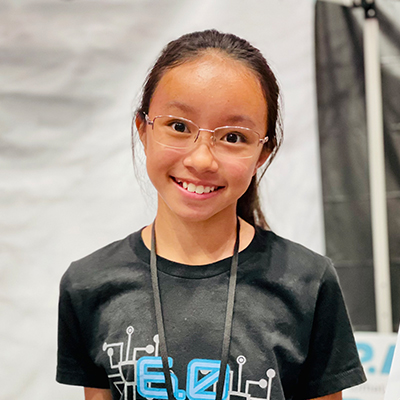
7th Grade, Granite Ridge Intermediate School
Fresno, CA
Transforming Waste Into Value: The Impact of Grape Pomace Variety and Extraction Parameters on Grape Seed Oil Yield and Physicochemical Properties
Project Background: Alice is from California’s Central Valley, which is known for its agriculture. But farming generates a lot of waste, including things like grape pomace, which is the solid results left over after grapes are pressed for juice or wine. “I am also aware that local farms struggle with low profitability, particularly due to harsh climate, and I’ve often wondered how I could help local farmers,” Alice says. After she visited Spain and saw how olive oil was made, she wondered if the remains of grapes could be used to produce cold-pressed grapeseed oil for farmers to sell.
Tactics and Results: Alice was given the opportunity to collect the grape pomace from Fresno State Winery during the 2024 harvest season. She got at least 500 grams of seeds from 10 varieties of grape, both red and white. She took the seeds, cleaned them and dried them with a food dehydrator. She then collected oil from the different seeds using an oil press and calculated how much oil she could get per mass of seeds. Alice analyzed the oils with a spectrophotometer for color, smelled them for scent, and measured their density and viscosity. She determined that the best extraction conditions were at 49 degrees Celsius with six percent water content, and that Pinot Noir, Tempranillo, and Syrah grapes produced the highest amounts of quality oil. Alice hopes that her results could help farmers boost their incomes by allowing them to sell oils as well as wines.
Other Interests: Alice has participated in the FIRST LEGO League Challenge for two seasons, and her team won the California Central Valley regional championship. She plays both piano and violin and volunteers with her friends to perform music at various nursing homes. Alice also volunteers with “The Heart of Cubs,” which raises money for important causes, and helped to raise more than $6,000 for the Valley Children’s Hospital. She’d like to be a chemist. “When I was little, I read a storybook about Madame Marie Curie and was inspired by her life. Since then, I’ve dreamed of becoming someone like her.”
Arshiya Ghosh

7th Grade, Starkey Ranch K-8 School
Odessa, FL
An Innovative Approach To Reduce Biofilm Formation & Progression: Evaluating the Impact of Antimicrobial Compounds on Thioredoxin-A in Biofilm for Colorectal Cancer Treatment
Project Background: Arshiya wants to become an oncologist. “Cancer is one of the most devastating challenges in our world, and I knew I wanted to contribute to the fight against it,” she says. She is especially interested in colorectal cancer, the fourth most common kind of cancer in the US. Cancer in the colon is more complicated because of the microbes that also live there. Arshiya worried that these complex bacterial communities – what Arshiya describes as biofilms – could “act as a shield, making treatments less effective.” She decided to test ways to break down this biofilm.
Tactics and Results: Arshiya focused on a protein called Thioredoxin A (Trx-A), a protein that can play a role in cell movement. She hoped that “reducing Trx-A activity will help weaken biofilms and improve treatments,” she says. Using a computer model, Arshiya tested four different molecules that could bind to Trx-A. She tried small hairpin RNAs (shRNAs), which can be used to stop some genes from being translated into proteins. She also tested auranofin, a gold-based salt, an antibiotic called oxacillin, dithiothreitol — a chemical that can inactivate TrX-A, and allicin, a compound derived from garlic, which is a treatment used in Ayurvedic medicine. Her computer models looked at each molecule’s 3D structure, and fit it with Trx-A. She showed that the shRNAs bonded best to Trx-A. Arshiya hopes to test real compounds in the lab to find out if they can help make colorectal cancer treatments more effective.
Other Interests: Arshiya loves computer science and coding. “It enhances my problem-solving skills,” she says. She plays the cello and does mixed martial arts. Arshiya hopes to become an oncologist — someone who treats cancer. “I have always been fascinated by biology, especially in understanding diseases like cancer, and I want to use this knowledge to help others,” she says. “The thought of being able to diagnose, treat, and bring hope to patients motivates me.”
Lia Camil González

8th Grade, Colegio Rosa-Bell
Guaynabo, PR
Evaluating the Effect of Spathodea campanulata (African Tulip) as an Ant Repellent To Protect Beehives
Project Background: Lia and her teammate, Anya Teron Villodas had discussed threats to honeybees with their teacher. “Bees play a vital role in ecosystems and agriculture, but they often face threats from predators that invade hives and disrupt their colonies,” Lia says. While they researched, they came across the African Tulip tree, Spathodea campanulata. “We noticed ants avoiding the tree or read about its possible insect-repellent effects,” Lia says. They decided to see if liquid from the tree could serve as a repellent.
Tactics and Results: The African Tulip tree is a large invasive tree in Puerto Rico. It forms hollow flower buds that fill with liquid. Anya and Lia wanted to find out if the liquid could serve as an ant repellant. They then built two model beehives. They placed tempting honeycomb in the dummy hives to attract ants and sprayed one hive with their African Tulip tree liquid. They checked the boxes every hour for four hours. After four hours, the control box had 183 ants, and 62 percent had reached the honeycomb. The African Tulip tree box had 91 dead ants. Meanwhile, the pair notices that bees flew into both boxes, attracted to the honeycomb, and appeared unaffected. The team concluded that the African Tulip tree liquid is capable of repelling and killing ants and hope to find out what compounds in the liquid make it effective.
Other Interests: Lia plays volleyball and has represented Puerto Rico in the Capitol Hill Volleyball classic tournament in Washington, D.C. She likes comics, and binge-watching movies and TV shows. “I also like drawing, coloring, arts and crafts because it keeps me out of electronics and at the same time it keeps me entertained,” she says. She would like to become a doctor. “Doctors not only heal but also provide comfort and hope to their patients. I admire their dedication and hard work, and I aspire to follow in their footsteps.”
Camila Isabel Gonzalez-Thompson
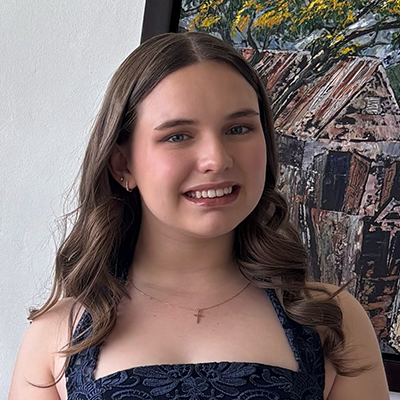
8th Grade, Caribbean School
Ponce, PR
Understanding IgG and IgM Seroprevalence of Dengue Virus in Southern Puerto Rico: A Key Step To Reduce Disease Burden
Project Background: In 2024, Puerto Rico declared an outbreak of dengue fever, with more than 6,000 cases. The viral infection is spread by mosquitoes. Most causes are mild, but serious ones can lead to shock and organ failure. Camila was surprised to find out that few people in her school knew about it. “In Puerto Rico, dengue is as common as the flu, yet many people know little about it or its serious side effects,” Camila says. She decided to find out just how common dengue infections were in her community.
Tactics and Results: Camila worked with a scientist at Ponce Health Science University to test people’s blood for whether they had been exposed to dengue. The immune system has different antibodies for dengue; someone who had dengue in the past will have more IgG antibodies, while someone who was exposed for the first time will have more IgM antibodies. Camila got serum samples from 440 people in Puerto Rico and found that people older than 50 had more IgG antibodies, meaning they had had dengue in the past. People younger than 50 had IgM antibodies, meaning they were being exposed to dengue for the first time. This means that dengue is endemic in Puerto Rico and has had more than one outbreak. Camila hopes that her work can help public health officials learn where to put out vaccines or work to prevent the disease.
Other Interests: Camila loves to dance, and for the past three years has also been performing in school plays. She likes hanging out with her friends and playing with her pets: dogs, cats, a parrot and a turtle. Camila is very passionate about public health, and volunteers at the student-run free clinic, Clínica del Sur in Ponce. She would like to become an immunologist. “By studying immunology, I hope to contribute to developing new ways to fight infectious diseases and improve lives in Puerto Rico and around the world,” she says.
Arya Hirsave

7th Grade, Canyon Vista Middle School
Austin, TX
Micro’fat’ories: Increasing Microalgal Biomass and Lipids for Biofuel Production
Project Background: When Arya’s science class was covering renewable and non-renewable energy last year, “the word ‘biomass’ piqued my interest,” she says. Fossil fuels are currently supplying most of the energy used around the world, and Arya is concerned about their role in climate change. She was excited to find out about renewable energy sources like algae, which can be grown to make biofuel, all while pulling CO₂ out of the atmosphere. She wanted to find out how to make algae grow faster and produce more oils to make them better sources for biofuels.
Tactics and Results: Arya took freshwater (Chlorella vulgaris and Chlorella pyrenoidosa) and saltwater algae (Nannochloropsis and Tetraselmis chuii) and measured how much and how quickly they grew. She showed that Chlorella vulgaris and Nannochloropsis grew fastest, which could make them better sources of biofuel. Arya then added vitamins B and C, as well as plant hormones to her algae. The vitamins boosted algae photosynthesis, leading to a six to seven percent increase in growth. Finally, she added salt to the freshwater algae and showed that while the algae didn’t grow as much, they did produce more lipids—important for biofuel production. The best result, Arya showed, was giving algae vitamins for three days, followed by high salt treatment for two days, enabling them to grow while increasing their lipid production by 77 percent in five days—highlighting microalgae’s potential as a more efficient biofuel source.
Other Interests: Arya has been participating in science fairs since third grade. “Science fair has been a way for me to figure out what I want to be when I grow up, and that is why I pick a project in a different category each year,” she says. Arya also loves any crafting project, from sewing to making miniature flowers. She would like to become an astrophysicist. Whether “searching up black hole TON 618 on Wikipedia or downloading the night sky app on my mom’s phone to see the constellations, the night sky never ceases to amaze me,” she says.
Matthew Kuo

8th Grade, Renner Middle School
Plano, TX
Factors Affecting Fuel Cell Energy Efficiency
Project Background: Matthew has always been interested in renewable energy. “In the past, I have explored solar panels and wind turbines, but this year I wanted to explore something unfamiliar,” he says. He became fascinated by fuel cells, energy sources that use chemical reactions to produce electricity. Matthew decided to study a proton exchange membrane fuel cell. These fuel cells use hydrogen ions to generate electricity. They can also perform electrolysis — splitting water molecules to produce the hydrogen they need. Matthew was curious to see how water quality might affect how his fuel cell performed.
Tactics and Results: Matthew compared two sources of energy, a wind turbine and a battery, to power his fuel cell. He showed the two methods have similar energy efficiency, at about 23 percent. Then, over 50 experiments, he compared water at different pHs, as well as adding salt, sugar and impurities to the water for the fuel cell. Matthew predicted that lower pH and fewer impurities would make his fuel cell more efficient. But he found that higher pH made his fuel cell more efficient. Impurities reduced efficiency, especially at higher pH. Adding salt significantly reduced efficiency at higher pHs, while sugar increased energy efficiency. Sugar and salt together at a high pH increased efficiency well, and Matthew hopes that perhaps certain levels of impurities like sugar and salt could help fuel cells perform better in the future.
Other Interests: Matthew likes “speed cubing”—racing to solve puzzles like a Rubix cube. He also likes sketching, creating and editing videos, and playing video games with his friends. He’s like to be a doctor, like his father. “I’ve developed a deep passion for medicine due to a strong scientific background in my family and my dad who works hard every day as a doctor,” he says. “I want my life to involve science, staying at the head of medical advancements.”
Tobias Lam

7th Grade, Long-View Micro School
Austin, TX
The Effect of Nintendo’s NES Tetris Theme Music and 28 Hertz High Beta-Frequency Binaural Beats on a 233 Hertz Carrier on Attention Span
Project Background: Tobias is concerned by how hard it is to focus, especially when he found that adults’ attention spans were four seconds shorter in 2024 than they were in 2000. “This is a big problem, and the effects have been seen even in classrooms where students have trouble focusing on the teacher,” he says. He is also interested in binaural beats, where a slightly different tone is played in each ear, making someone hear an illusion of a pulsing beat. Binaural beats may help people achieve meditative states. As a passionate musician, Tobias wondered if they could help people focus.
Tactics and Results: Tobias tested 65 people online for their reaction time and accuracy in a task. One third took the test in silence, while another third heard the theme song from the Nintendo game Tetris for half of their tests. The final third heard binaural beats at 28 Hz — a frequency linked to improved concentration — for half of their tests. Tobias found that the video game music didn’t help anyone’s concentration. “Many participants found it hard to focus while listening to video game music,” he says. But people who listened to binaural beats performed better on the task than those who listened to nothing. While none of Tobias’s tests proved to be statistically significant, he hopes that more participants and a longer test might help him understand how music affects focus.
Other Interests: Tobias has been playing piano since he was five years old, and his love of music has inspired several of his science fair projects. “Music and piano have always affected other areas of my life and are a large part of what gives me inspiration for many types of activities.” He plays the piano at senior homes and says seeing his audience react to his music “makes playing at senior homes as rewarding for me as it is for the seniors there.” He would like to become a chemist.
Paola Sofia Lumbreras
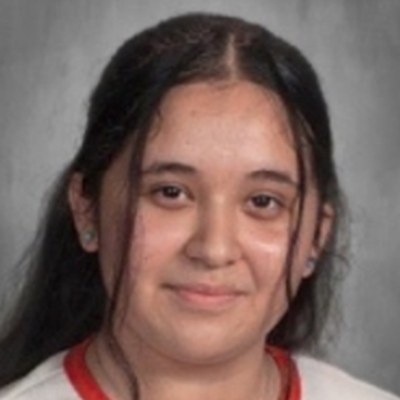
8th Grade, Acton Middle School
Granbury, TX
Investigating Natural Antioxidants as Protective Agents Against Alcohol and Nicotine-Induced Fetal Developmental Abnormalities
Project Background: When Paola learned about the effects that vaping nicotine can have on fetal development, she began to wonder how to protect developing fetuses from the effects of alcohol and nicotine. “What really inspired me was thinking about maternal health disparities and how some pregnancies don’t receive adequate protection,” she says. “I kept asking myself – what if there was something simple and natural that could help?” Paola decided to look at the effects of antioxidants on fetal development in zebrafish.
Tactics and Results: Paola knew that nicotine and alcohol both cause damage to fetuses by creating highly reactive oxygen species that attack other molecules in the cell, including DNA. She reasoned that antioxidants might neutralize the harmful chemicals and reduce damage to developing cells. She exposed fish embryos in her high school science department to alcohol, nicotine, or both for an hour, and tested some of the groups as well with vitamin C or with spinach extract, two sources of antioxidants. Paola measured embryo survival, heartrate, length and if they developed abnormalities. She found that nicotine caused the largest drop in embryo survival, from 91.4 percent to 72.3 percent, and that it also made embryos’ hearts beat faster and increased deformity. Alcohol slowed heart rate, and both alcohol and nicotine slowed growth. Paola showed that both vitamin C and spinach extract helped protect the fish, increasing survival and growth, and reducing abnormalities.
Other Interests: Paola plays the tuba and has been in middle school honors band for two years. Heading into high school, she’s excited to join the marching band. “I now get to join my older brother on the tuba marching line,” she says. Paola continues to volunteer with her middle school band, teaching the youngest kids the ropes, though “the kids were a handful.” She also likes weightlifting. After taking an engineering class and doing a project about planes, Paola would like to become an aeronautical engineer.
Luca McGill

8th Grade, Emily Gray Junior High School
Tucson, AZ
ALTO-CO₂: Low-Cost Drone-Based Atmospheric Carbon Dioxide Monitoring Across Urban, Suburban, and Rural Areas in Southern Arizona
Project Background: Luca likes to play outdoor sports, but in Arizona, it’s not always safe. There can be intense heat, dust storms and bad air quality during wildfire season. “Sometimes Tucson has warnings about bad air, but it’s hard to know how accurate they are for different places or times of day,” Luca says. “When I visit my grandparents in Germany every summer, I’ve noticed air quality is monitored more closely.” He wondered if he could use a drone to better monitor air quality in Arizona.
Tactics and Results: Luca decided to monitor carbon dioxide levels at different altitudes in urban, rural and suburban environments. He equipped his DJI Mini 2 drone with a CO₂ sensor and a Raspberry Pi. Then he flew his drone carefully along the same vertical path in an urban, suburban and rural area on Sundays. The drone hovered every 15 meters from the ground up to 120 meters. He also kept track of nearby traffic and weather patterns. Luca thought that urban environments would have the highest CO₂ near the ground, due to traffic. But his measures showed that rural areas had the highest CO₂ close to the ground, while urban areas had even levels of CO₂ across altitudes. Suburban areas, he showed, had high CO₂ at both high and low altitudes, with a dip in the middle. The method, Luca says, shows a low-cost way to provide more detailed CO₂ data.
Other Interests: Luca is a second-degree black belt in the Korean martial art Dang Soo Do and helps out as an assistant instructor. “I love the physical challenge, but what I enjoy most is teaching younger students and giving back to the community that taught me,” he says. He also volunteers as a junior handler in training with the Alliance of Therapy Dogs, taking his family’s certified therapy dog to senior homes, hospitals and more. Luca would like to be a climatologist. “Climate change is one of the biggest challenges of our time, and I want to help solve it.”
Pranshi Mehta
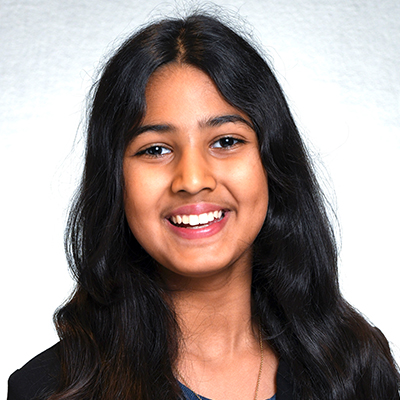
7th Grade, Canyon Vista Middle School
Austin, TX
Machine Learning-Mediated Computational Modeling of FK506-Binding Protein 12 (FKBP12)-Enhanced CAR T-Cell Therapy for Targeted Glioblastoma Treatment
Project Background: When Pranshi’s best friend lost her mother to cancer, Pranshi began to wonder why some cancers can be treated successfully while others can’t. She discovered CAR T-cell therapy—which takes the immune system T cells from a cancer patient and genetically alters them to produce antibodies to attack the cancer. CAR T-cell therapy works well for blood cancers, but not in solid cancers like glioblastoma. “I wanted to understand why this therapy worked in some cancers but not others, and whether artificial intelligence tools could help find answers,” Pranshi says.
Tactics and Results: Pranshi decided to focus on glioblastoma, one of the most aggressive and lethal brain cancers. She wanted to look for potential antibodies that could bind to FKBP12, a protein that is overexpressed in glioblastoma. She then used the modeling program AlphaFold3 to generate a 3D structure of FKBP12, to select the best regions for an antibody to bind. Pranshi picked 28 antibodies that might fit and used a protein simulator to see how well each one would fit on to the protein and calculated how strong the binding would be. She ended up with one antibody called 3D85, which stayed bonded to FKBP12 for 10 nanoseconds. Her result shows a way to use AI to find new antibodies quickly. The next step, Pranshi says. “is to experimentally validate these antibody candidates and integrate them into functional CAR constructs.”
Other Interests: Pranshi plays the piano, performs monthly at retirement homes, and has performed twice at Carnegie Hall. She loves to write and is currently working on her third book. Pranshi also likes to go on bike rides with her friends, and to swim. “I swim to clear my head, and the rhythm of the laps has sparked many of my best Eureka moments, including my research,” she says. She would like to go into health care. “Health care combines science, art, and service, my three passion points,” she says.
Akhil Nagori

8th Grade, Juan Cabrillo Middle School
Santa Clara, CA
Visionary: AI Glasses for Real-Time Text-to-Audio Transcription To Help Visually Impaired Students
Project Background: When visiting his grandparents in India, Akhil saw his visually impaired grandfather struggle to read Braille. “He had originally had eyesight, but had lost it over time, and it was painful to see him spend so many hours struggling to read the papers,” Akhil says. He also learned that less than one percent of educational books are available to visually impaired kids. Akhil told his teammates Evann Sun and Lucas Yen, and they decided to develop a pair of glasses that could translate text to audio.
Tactics and Results: The team wanted to teach an AI model to “read” different fonts and layouts of text and translate them to speech. They started with a dataset of 800 classroom text images from books, worksheets and other class materials, to train the AI on colorful backgrounds and fonts. The team designed a frame, a pair of 3D-printed glasses that would contain a Raspberry Pi, a tiny camera, a battery, and a small pair of speakers. The glasses were programmed to take pictures, extract the text from them, and used an eSpeak library to convert the text to speech, which is played through the speakers mounted on the glasses’ frame. Akhil oversaw the code to run the glasses. The team tested their glasses in high, low, and medium light with tough to read text. Their glasses successfully read the text aloud 92 percent of the time.
Other Interests: Akhil is working on his gardening skills. “Not only does it give me the pleasure of taking care of it,” he says, “but also the delicious harvest I receive at the end of the season” is another reward. Akhil also likes robotics and used access to a makerspace as part of the 49ers STEM Leadership Institute to build a gravity-powered car that can go uphill. Akhil would like to be a computer scientist. “Ever since I was introduced to Python and LeetCode, I was always fascinated by the things computers could do so quickly,” he says.
Yookta Pandit
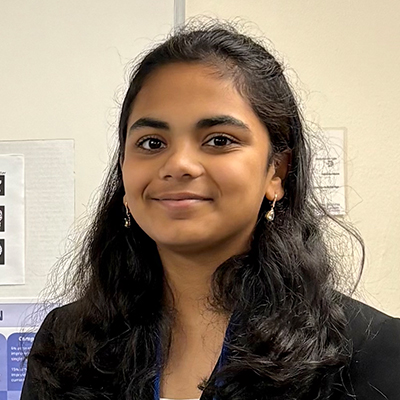
8th Grade, The Quarry Lane School
Dublin, CA
Reading the Brain: Using MRIs for Early Detection of Dyslexia
Project Background: Yookta has always loved to read. One of her favorite book series, Percy Jackson & the Olympians, taught her that many kids struggle with reading because of dyslexia. “When I did my research on dyslexia, I found that one in ten children in America struggle with it and do not get timely help, because detection is hard. I wanted to help them enjoy reading as much as I did,” Yookta says. After taking a neuroscience class and one about AI, she decided to combine the two to try and detect dyslexia.
Tactics and Results: Yookta looked for publicly available data sets of Magnetic Resonance Images (MRI), which show clear anatomy of the brain. She found scans from 40 children and adults with dyslexia and 42 controls. She divided the brain into 132 anatomical parts. Yookta used the different features to train her AI model, which compared the sizes of the regions between controls and people with dyslexia. Her first effort achieved only 56.23 percent accuracy, but she then developed more models and trained the AI on specific brain areas, like the right entorhinal area, the left posterior orbital gyrus, and other brain areas linked to memory, navigation, reward and emotion. By trial three, her AI was trained to find differences between dyslexic and control brains at 87.5 percent accuracy.
Other Interests: Yookta loves to read, and she especially loves fantasy series like Percy Jackson & the Olympians. She is also on a swim team, and swims around two miles every day. Yookta is also a part of the AI Ambassadors program, learning about applications of AI. She would like to become a computer scientist. “I am excited to continue researching in computer science and believe that this career is the best way for me to have an impact on the world.”
Owen Thomas McGeeney Park

7th Grade, Saint Francis of Assisi Catholic School
Louisville, KY
A Breakthrough in Low-Voltage Regolith Mitigation
Project Background: Owen is concerned about dust. Martian dust, specifically. The Red Planet is very dry and covered in regolith — loose rock and dust. That dust will cling to machinery that lands there — and people, too. Martian rovers must contend with dust that gets into their gears and coats the solar panels that provide them with power. “My project this year aimed to solve the problem of dust adhering to rovers,” Owen says.
Tactics and Results: “I found that the most effective way to do this would be to build an electrodynamic dust shield, or EDS, but I then found that NASA had already done it,” Owen says. EDS uses an electrical field to lift dust away from surfaces. But then Owen learned that the EDS NASA currently uses needs 2000 volts of electricity — about what it takes to power a microwave. He wondered if he could do it with lower voltage. He set up his own electrodynamic dust shield with combs, plexiglass, wires, and glue, hooked up to a small power supply. He found that at only two volts, his EDS could clear 71.21 percent of dust dropped in normal Earth atmosphere, and 71.43 percent of dust in a vacuum chamber he used to simulate Mars. At 50 volts, it cleared 73.06 percent of Earth dust and 76.92 percent of dust in his Mars simulation.
Other Interests: Owen likes physical sports like swimming and volleyball, but he also likes mental sports like chess and cubing — racing to solve Rubix cube-like puzzles. He also likes playing the card game Magic: The Gathering with his friends. He would like to be a physicist. “I love how everything fits together when you try to connect them and how there are so many things that we still don’t understand,” he says.
Caden Terence Pohlkamp
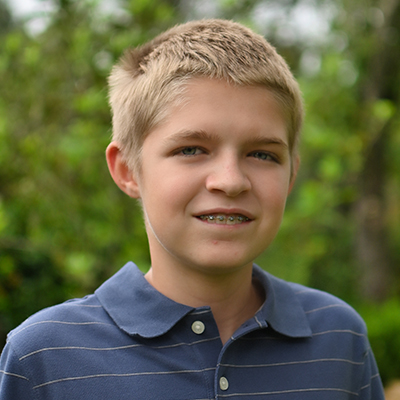
7th Grade, Brookside Intermediate School
Friendswood, TX
Is More Green Better? Does Littoral Vegetation Enhance Habitat Suitability of Local Retention Ponds?
Project Background: Living near the Gulf of Mexico, Caden is interested in how communities control flooding from extreme weather events. He found out that many of the man-made ponds around his town are required—they collect and control water during storms. “If our community is going to build retention ponds, I wanted to know the optimal way to design them to provide suitable habitats for the local marine life I am passionate about,” he says. Caden decided to build a remote-operated vehicle to investigate the health of his town’s ponds.
Tactics and Results: Caden built a small remote-operated vehicle (ROV) that could scoot to the bottom of retention ponds and bring back water samples. He then took samples of 12 different ponds around his community and measured the pH, the amount of oxygen consumed by living things in the water, the dissolved oxygen, turbidity, phosphate, temperature and more. He used these to determine how much life the ponds could support. Caden showed that the ideal pond has between 15 and 30 percent non-grass vegetation around its edge. Healthy ponds have large amounts of dissolved oxygen and ideal pH. He also showed that retention ponds with fountains had better dissolved oxygen, making them more hospitable for life. Ponds without fountains, he showed, had measures that suggested a lot of algae, gobbling up the oxygen. He communicated his findings to officials, so they could act on any unhealthy ponds.
Other Interests: Caden loves taking care of his guinea pigs and his 10-gallon aquarium. “When I was five years old, my mom took me to Sea World and I fell in love with marine life,” he says. He wants to become a marine veterinarian and biologist. He loves reading about the ocean, and sneaks in big books to read in school. “My parents say the extra weight in my backpack is bad for my back, but I disagree,” he says. He also participates in the Texas A&M Galveston Sea Camp, and volunteers at local beach cleanups to protect marine life.
Brady Ryan Sage
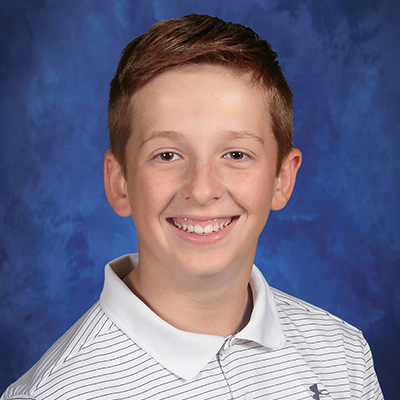
8th Grade, Saint Thomas More Middle School
Rapid City, SD
Optimizing Driver Flight Distance and Accuracy
Project Background: Brady loves to play golf and is always trying to improve his game. “Over the years of playing golf, I have struggled with determining the correct tee height and the optimal placement of the ball in my stance when using a driver,” he says. Because the driver hits the first long distance shot down the green, a long shot with backspin yields the best distance with control. But if Brady tested all the variables himself, he’d quickly wear out from so many drives. He decided to build a machine to hit the ball the same way every time.
Tactics and Results: Brady modified a clay pigeon launcher, making it rotate the clubhead of a driver to hit a golf ball. He brought the machine to a golf simulator, and used it to test four different tee heights, 3 cm, 2.5 cm, 2 cm, and 1.5 cm, and three different tee positions: Centered, 2 cm forward and 2 cm back. The launch monitor on the golf simulator then told him which balls would fly the farthest and have the most backspin. He tested each position 10 times, and found that the second-highest tee, positioned 2 cm forward, gave him the best total distance -– it kept the ball in the air for the second-longest amount of time, and the ball still rolled when it landed. But it was the highest tee, furthest back, that gave him the most backspin, increasing his control when the ball hit the ground.
Other Interests: Obviously, Brady loves to play golf. He has been competing for the past four years. Brady also likes Destination Imagination, a team-based creative science competition. “I enjoy golf, Destination Imagination (DI), and skiing the most because they require mental and physical endurance and perseverance,” he says. Brady also plays trumpet at his church for special masses and funerals, and volunteers for church events making balloon animals. He’d like to be a mechanical engineer. “I think it’s fun to imagine machines that would make life more efficient and help people,” he says.
Simone Smith
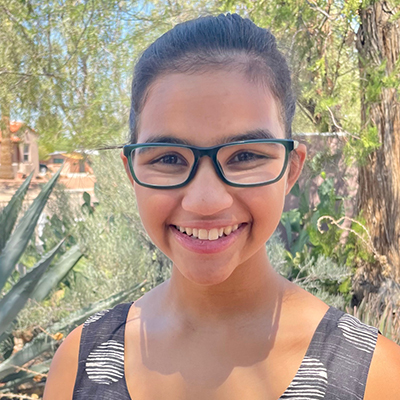
8th Grade, Saint Cyril of Alexandria School
Tucson, AZ
Catching Deadly Butterflies
Project Background: When Simone first learned about Artificial Intelligence Machine Learning (AIML) in 2022, she created programs to tell cats from dogs and chihuahuas from blueberry muffins. But once she had the hang of it, “I wanted to apply what I learned about AIML from Girls Who Code to a real word problem to help people.” She then learned about the use of PFM-1 mines, otherwise known as “Butterfly mines,” being used in the war between Russia and Ukraine. The mines are the size of someone’s palm, bright green — and kids often mistake them for toys.
Tactics and Results: Simone decided to find out if an AI model could be trained to find PFM-1 landmines against different backgrounds. She first developed a 3-D printed model of the PFM-1, a small plastic butterfly shape that is designed to glide and scatter when dropped from the air. She spray painted her models green, brown or tan to mimic common colors. Simone took 100 photos of the mines against landscape features like rocks, grass, asphalt or dirt, and another 300 photos of the landscapes without the mines and fed the photos in to train her AI. She found out the AI model could spy the mines accurately about 90 percent against grass. Rocks and asphalt proved hardest as the varied rock background confused the model, and asphalt created shadows. But with more training, the model improved, and she ended up with 90 percent accuracy overall.
Other Interests: Simone’s favorite activity is swim team, “because I am on a team with all types of people, learn to work hard, and have to do my best.” She also likes to volunteer at the Tucson Village Farm as a junior camp counselor, where she plants and harvest vegetables, and helps campers gently handle the baby chickens. Simone would like to be a computer engineer. “I especially like how computer engineers ensure that the hardware and software parts of the computers work together and do their job to accomplish a task.”
Sam Daniel Solhpour
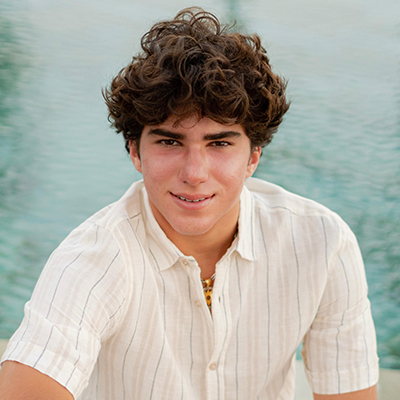
8th Grade, Corona Del Mar Middle School
Newport Beach, CA
Forecasting Renewable Energy Production Based on Historical Weather Data in California: Predictive Analysis Using Regression Modeling
Project Background: In August of 2024, California asked residents to save power at night so the electric grid wouldn’t fail when solar panels stopped producing energy after dark. “My tennis practice was canceled, our house went half-dark, and I heard a radio reporter say, ‘No one knows exactly how much renewable power will be available each hour,’” Sam says. “That really stuck with me. If we can predict the weather, why can’t we predict tomorrow’s solar and wind power?” He decided to see if he could create more accurate weather forecasts to better predict energy availability.
Tactics and Results: Sam gathered solar and wind energy data in California from 2022 and 2023. He used a linear regression model to align the renewable energy data with weather factors from the same days, including temperature, cloud cover, solar radiation, wind speed, and day length. He then looked for correlations between the weather and the output of solar and wind energy and developed a predictive model that could use the weather to predict energy output. His model explained 97 percent of variation in solar energy, with an error of around 10,780 Megawatt hours per day, about 39 percent of daily solar energy production. His model explained 89 percent of variability in wind energy production, with error of around 15,793 Megawatt hours per day, or 42 percent of wind energy production. He suggests that his more precise predictions could help cut 9,100 metric tons of CO₂ emissions daily.
Other Interests: Sam loves both tennis and basketball. He also likes biking, it “helps me clear my mind and appreciate nature,” he says. Sam volunteers to help people who are unhoused, doing food drives and community events. He would like to be a computer scientist. “I love using data and code to solve real-world problems,” he says. “I want to use these skills to build smarter systems that help people, protect the environment, and make the world more efficient and sustainable.”
Evann Sun
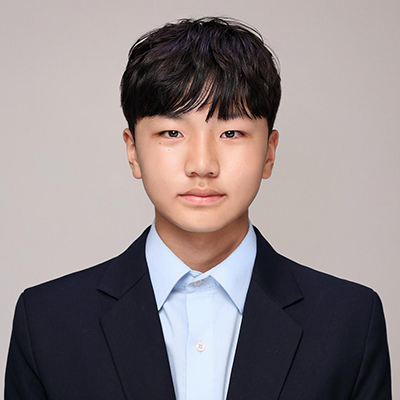
8th Grade, Juan Cabrillo Middle School
Santa Clara, CA
Visionary: AI Glasses for Real-Time Text-to-Audio Transcription To Help Visually Impaired Students
Project Background: When Evann’s teammate Akhil Nagori visited his grandfather in India, he saw how much he struggled to read Braille as part of his work. He told his teammates Evann and Lucas Yen, and “together we decided to focus on a project that would support individuals with visual impairments,” Evann says. The team decided to focus on school materials for the visually impaired. “Every student, regardless of visual ability, deserves equal opportunities,” he says, and that means being able to read the textbook.
Tactics and Results: The team wanted to teach an AI model to “read” different fonts and layouts of text and translate them to speech. They started with a dataset of 800 classroom text images from books, worksheets and other class materials, to train the AI on colorful backgrounds and fonts. Evann oversaw designing the frame, a pair of 3D-printed glasses that would contain a Raspberry Pi, a tiny camera, a battery, and a small pair of speakers. The glasses were programmed to take pictures, extract the text from them, and used an eSpeak library to convert the text to speech, which is played through the speakers mounted on the glasses’ frame. The team tested their glasses in high, low, and medium light with tough to read text. Their glasses successfully read the text aloud 92 percent of the time.
Other Interests: Evann loves basketball. “It’s an incredibly fun and engaging game that not only builds skills you can use on the court, but also valuable life skills off the court,” he says. He’s been interested in technology for as long as he can remember. When his parents laid out objects for him to choose from on his first birthday, “out of everything, I reached for a flip phone.” He’d like to become a mechanical engineer. “Your work can have a meaningful impact on millions of lives,” he says.
Anya Zahira Terón Villodas
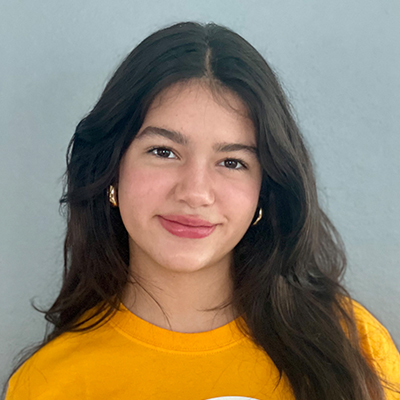
8th Grade, Colegio Rosa-Bell
Guaynabo, PR
Evaluating the Effect of Spathodea campanulata (African Tulip) as an Ant Repellent To Protect Beehives
Project Background: When Anya’s sister did science fair, she worked on honeybees. Anya and her teammate Lia Camil González picked up her concerns about these important pollinators. Populations of honeybees are declining due to threats from disease, pests and environmental stress. “We realized how important honeybees are to our ecosystem, making this a problem we wanted to find a solution for,” Anya says. The team decided to find out how to repel the ants that can invade beehives, and came across the African Tulip tree, Spathodea campanulata.
Tactics and Results: The African Tulip tree is a large invasive tree in Puerto Rico. It forms hollow flower buds that fill with liquid. Anya and Lia Camil wanted to find out if the liquid could serve as an ant repellant. They built two model beehives. The team placed tempting honeycomb in the dummy hives to attract ants and sprayed one hive with African Tulip tree liquid. They checked the boxes every hour for four hours. After four hours, the control box had 183 ants, and 62 percent had reached the honeycomb. The African Tulip tree box had 91 dead ants. Meanwhile, the pair notices that bees flew into both boxes, attracted to the honeycomb, and appeared unaffected. The team concluded that the African Tulip tree liquid is capable of repelling and killing ants and hope to find out what compounds in the liquid make it effective.
Other Interests: Anya loves to play soccer. While it’s a demanding sport, it makes her feel free, “and a sip of water after soccer practice might be one of the best things ever,” she says. Anya has also done modeling. She hopes to be a chemist. Anya suffers from dermographism, where the skin forms large welts after being scratched, and keratosis pilaris, where her skin forms small round bumps. “These conditions have made me cautious of what ingredients my skincare products contain,” Anya says. She hopes to design products to help other people with the conditions.
Sanhita Tummala

8th Grade, George S. Mickelson Middle School
Brookings, SD
A Novel Self-Sustainable Kit To Combat Rural Vitamin A Deficiency During Pregnancy and Early Childhood
Project Background: People who don’t get enough vitamin A can suffer from night blindness, or even total blindness. More than 19 million pregnant women and 30 million children under five don’t get enough vitamin A. Sanhita learned about this during a late-night YouTube rabbit hole. “Solutions like sending supplements are often not possible for inaccessible regions of the world, which are those most affected,” she says. Sanhita began to wonder if she could create a way for people to produce their own vitamin A at home. She decided to develop a fermentation kit to produce Vitamin A’s precursor, beta-carotene.
Tactics and Results: Sanhita selected the mold Blakeslea trispora for her kit, a microbe that is used to produce beta-carotene for things like food coloring. For a high-starch environment to grow her microbes, she chose cassava starch (tapioca), because it is very prevalent in areas where people have a vitamin A deficiency. Sanhita fermented the tapioca with the mold as a solid and a liquid for up to nine days and then tested how to freeze-dry or oven-dry her molds, measuring the beta-carotene they produced. At first, her molds didn’t produce any beta-carotene at all, and Sanhita turned to the literature, finding that she needed to add minerals to trigger it. She found that freeze-drying improved the beta-carotene yield by 68 percent compared to oven-drying. Sanhita’s methods were able to produce 84.22 micrograms/gram of dry-weight of beta-carotene, and she hopes this will be the foundation for a vitamin A-producing fermentation kit in the future.
Other Interests: Sanhita loves to dance and draw. “In my free time, I find myself opening my sketchbook and drawing unique artwork,” she says. While her small town doesn’t offer a lot of STEM opportunities, she says, Sanhita learned to create her own. “Science innovation doesn’t necessarily require high-tech labs—often, it’s the simplest of ideas, things maybe even a middle schooler may be able to think of, that prove to be the most effective solutions.” She would like to become a biomedical engineer.
Bhavya Uppalapati

7th Grade, Rachel Carson Middle School
Herndon, VA
RiFT: A Low-Cost, Rice Flour-Derived Trojan Horse Nanocarrier System for the Eradication of Methicillin-Resistant Staphylococcus aureus
Project Background: Many members of Bhavya’s family work in healthcare, and have been infected with MRSA — Methicillin-Resistant Staphylococcus aureus. “Even though there were low-cost antibiotics available to help my family, all of them failed within days,” she says. MRSA infections are often on the skin, where they can be deep and painful. If they get inside the body they can create potentially-deadly infections—and they are resistant to many antibiotics. Bhavya decided to develop a way to deliver antibiotics against MRSA more effectively on the skin.
Tactics and Results: Bhavya learned that the tiny granules in rice flour could be used to carry small chemicals to put on skin. She used rice flour, xanthan gum, and beeswax in a 3D bioprinter to make a filament. She loaded her rice flour carrier with the antibiotic doxycycline and ascorbic acid and mixed it into a topical cream. Bhavya also added fluorescent microspheres so she could track drug delivery. “I did not have access to live MRSA cultures for my work due to biosafety restrictions,” she notes, so instead she used a silicone polymer that could mimic a cell membrane with a negative electric charge—like MRSA bacterium. She applied her cream and a control cream to the membrane, and measured how deep the drugs went, and showed that her carrier could penetrate the barrier. Bhavya also used computer models to show how the doxycycline would bind with an enzyme in MRSA.
Other Interests: Bhavya suffers from melioidosis, a rare kind of chronic bacterial infection, and has been an intern with the Rare Disease Council of America SRES internship. Bhavya would like to be a biomedical engineer. “Discovering the cures for some of the world’s most important diseases is an important feat, delivering these medicines at a low-cost, and making sure they can combat resistance is a crucial final step,” she says.
Siddharth Sudharshan Vazhkudai

7th Grade, Running Brushy Middle School
Cedar Park, TX
AIM-BASE: AI-Integrated Model To Predict the Energy Consumption of Extra-Terrestrial Colonies
Project Background: Siddharth has been fascinated with energy conservation since he came across a museum exhibit years ago “It was a game where one managed energy sources to sustain a moderately large city. I loved it. That night, I started looking up how different energy sources work and how they’re used to power things,” he says. Later, he became interested in space, especially colonies on Mars. “When I learned about the science fair, I wanted to combine those two passions—energy and space,” he says.
Tactics and Results: Siddharth decided to create a computer model that could predict the energy needs of a Martian colony. “Before starting my project, I researched technologies like MOXIE, which produces oxygen from Martian CO₂, and studied the environmental conditions that must be modeled for life on Mars,” he says. He considered different life requirements on Mars: Water, oxygen agriculture for food production, infrastructure like plumbing and electricity, energy production, and of course, scientific experiments. Siddharth used Python to code analytical models and combined it with artificial intelligence. He trained the AI on Earth environments like deserts and Antarctic research stations, so that it would adjust the energy consumption and resource allocation as needed. He showed that this model “AIM-BASE,” can switch technologies under different conditions, and propose better ways to use energy, like reducing heating. He hopes that models like his could someday help manage life on the red planet.
Other Interests: Siddharth may love space, but plants keep him down-to-Earth. “I believe that the need of the hour is to combat deforestation which can reduce the effects of climate change. I volunteer for an organization called TreeFolks, where we plant thousands of native plants around Austin. I also volunteer at a ranch-size animal shelter, clearing enclosures and caring for the animals,” he says. “Gardening offers another wonder: tending seedlings with my grandfather and learning patience as each sprout grows.” He would like to become an astrophysicist.
Christine Wang

7th Grade, The Harker School – Middle School
San Jose, CA
Peel To Purify: An Innovative Fruit Waste-Based Solution for Contaminated Water Treatment
Project Background: “As a Californian, I have always assumed that clean water was a guarantee,” Christine says. She was horrified to learn in in her science class that heavy metals can cause nervous system damage and “even schools and businesses in my own community were failing to meet heavy metal drinking water safety standards.” Christine did more research and found that water filtering can be very expensive, especially for people who need it the most. She also knew about the large amounts of food waste people produce. Christine decided to see if fruit peels from waste could make a sustainable water filter.
Tactics and Results: Christine worked on her project with a partner, Jingwei Guo. They learned that fruit peels contain compounds like pectin and cellulose which can bond to heavy metals, making them a potential filter. The team tested four types of fruit peel: Orange, lemon, banana, and pomelo. They ground up dried peels into powders and tested to see if the powders could remove lead, cadmium, copper, iron, zinc, silver, and nickel. Their test strip results showed that all fruit peels reduced heavy metals. They all removed 10 parts per million of lead, cadmium, and nickel — leaving undetectable levels. The team also tried combinations of peels and found a banana-lemon combination and all four peels together could filter heavy metals to better than the EPA standard. Finally, the team looked at bacteria and showed the filter could reduce E. coli levels by 83 percent and made dirty water clear again.
Other Interests: Christine loves writing and playing water polo. Water polo, she says, is full of energy and strategy. Writing, “is where I slow down to capture small moments.” She also runs a book exchange for the American Cancer Society. The book exchange isn’t “just about collecting donations; it’s about handing kids the pages that let them rewrite their futures,” she says. Christine would like to be an environmental engineer. “My vision is to develop hybrid systems where organic materials handle initial water filtration, while wetlands restore biodiversity.”
Miles Wu

8th Grade, Hunter College High School
New York, NY
Optimizing the Strength-to-Weight Ratio of Miura-Ori Patterns
Project Background: Miles has been folding origami for seven years. In the past year, he became fascinated with the Miura-Ori, or Miura fold, which folds a flat sheet into a much smaller area with a tessellating series of parallelograms. At the same time, Miles also started reading about recent natural disasters like the L.A. wildfires and Hurricane Helene. “I wondered if Miura-Ori origami folds could be utilized in deployable shelters, since they are known for their strength, flat-foldability and portability,” he says. He decided to test different versions of the fold to find the one that could support the most weight.
Tactics and Results: To find out which folds were strongest, Miles tested two different parallelogram heights (one and two inches), three widths (0.5, one, and two inches), and three angles of fold (45, 60, and 75 degrees). He also varied the weight of the paper, from copy paper to heavy cardstock. Miles ended up with 54 different variants that each opened up to 64 square inches, about two-thirds of the size of a sheet of copy paper. He set them between guardrails to make sure they were opened to five inches apart and put increasing weights on them until they collapsed. The folds proved even stronger than he anticipated, supporting 9,069 times their own weight. “I had to purchase fifty-pound exercise weights in order to accurately run trials,” he says. Miles found that smaller panels with steeper angles between them ended up stronger, and that copy paper proved the strongest paper.
Other Interests: Miles’ origami habit got serious during the pandemic, and he submitted his creations to a competition called Origami By Children. His work has even been featured in the American Museum of Natural History on its holiday tree. He has also folded and sold 200 origami pigeons of his own design to benefit the Wild Bird Fund. Someday, he’d like to publish his own origami book. Miles would like to be a biologist and is especially interested in how animals and plants can survive and thrive in cities.
Lucas Shengwen Yen

8th Grade, Juan Cabrillo Middle School
Santa Clara, CA
Visionary: AI Glasses for Real-Time Text-to-Audio Transcription To Help Visually Impaired Students
Project Background: When Lucas’ teammate Akhil Nagori visited his grandfather in India, he saw how much he struggled to read Braille as part of his work. Akhil told his teammates Lucas and Evann Sun, and they decided to focus on technology that could benefit students. “The only blind school in California is located in a neighboring city, Fremont,” Lucas says. “The average house price here is 1.6 million, making it impossible for most families to afford.” He also learned that “only around 10-15 percent of blind children understand braille.” The team decided to develop a pair of AI glasses to take textbook text and “read” it aloud.
Tactics and Results: The team wanted to teach an AI model to “read” different fonts and layouts of text and translate them to speech. They started with a dataset of 800 classroom text images from books, worksheets and other class materials, to train the AI on colorful backgrounds and fonts. The team designed a pair of 3D-printed glasses that would contain a Raspberry Pi, a tiny camera, a battery, and a small pair of speakers. The glasses were programmed to take pictures, extract the text from them, and used an eSpeak library to convert the text to speech, which is played through the speakers mounted on the glasses’ frame. Lucas oversaw testing and collecting data on the glasses in high, low, and medium light with tough to read text. Their glasses successfully read the text aloud 92 percent of the time.
Other Interests: Lucas likes to play volleyball. “I love the game’s strengthened teamwork and communication, fast pace, and involved strategy. Because I played volleyball, I learned how to stay calm when under pressure, support all of my teammates, and push myself physically and mentally,” he says. He’d like to become a doctor like his mother. “I have been deeply inspired by watching her care for others,” he says. “Her work changes people’s lives daily. It showed me that compassion, dedication, also knowledge are valuable.”

